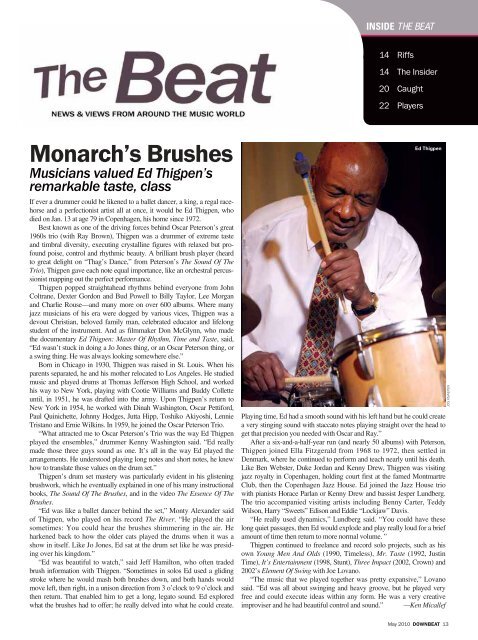Download - Downbeat
Download - Downbeat
Download - Downbeat
- No tags were found...
Create successful ePaper yourself
Turn your PDF publications into a flip-book with our unique Google optimized e-Paper software.
INSIDE THE BEAT14 Riffs14 The Insider20 Caught22 PlayersMonarch’s BrushesMusicians valued Ed Thigpen’sremarkable taste, classIf ever a drummer could be likened to a ballet dancer, a king, a regal racehorseand a perfectionist artist all at once, it would be Ed Thigpen, whodied on Jan. 13 at age 79 in Copenhagen, his home since 1972.Best known as one of the driving forces behind Oscar Peterson’s great1960s trio (with Ray Brown), Thigpen was a drummer of extreme tasteand timbral diversity, executing crystalline figures with relaxed but profoundpoise, control and rhythmic beauty. A brilliant brush player (heardto great delight on “Thag’s Dance,” from Peterson’s The Sound Of TheTrio), Thigpen gave each note equal importance, like an orchestral percussionistmapping out the perfect performance.Thigpen popped straightahead rhythms behind everyone from JohnColtrane, Dexter Gordon and Bud Powell to Billy Taylor, Lee Morganand Charlie Rouse—and many more on over 600 albums. Where manyjazz musicians of his era were dogged by various vices, Thigpen was adevout Christian, beloved family man, celebrated educator and lifelongstudent of the instrument. And as filmmaker Don McGlynn, who madethe documentary Ed Thigpen: Master Of Rhythm, Time and Taste, said,“Ed wasn’t stuck in doing a Jo Jones thing, or an Oscar Peterson thing, ora swing thing. He was always looking somewhere else.”Born in Chicago in 1930, Thigpen was raised in St. Louis. When hisparents separated, he and his mother relocated to Los Angeles. He studiedmusic and played drums at Thomas Jefferson High School, and workedhis way to New York, playing with Cootie Williams and Buddy Colletteuntil, in 1951, he was drafted into the army. Upon Thigpen’s return toNew York in 1954, he worked with Dinah Washington, Oscar Pettiford,Paul Quinichette, Johnny Hodges, Jutta Hipp, Toshiko Akiyoshi, LennieTristano and Ernie Wilkins. In 1959, he joined the Oscar Peterson Trio.“What attracted me to Oscar Peterson’s Trio was the way Ed Thigpenplayed the ensembles,” drummer Kenny Washington said. “Ed reallymade those three guys sound as one. It’s all in the way Ed played thearrangements. He understood playing long notes and short notes, he knewhow to translate those values on the drum set.”Thigpen’s drum set mastery was particularly evident in his glisteningbrushwork, which he eventually explained in one of his many instructionalbooks, The Sound Of The Brushes, and in the video The Essence Of TheBrushes.“Ed was like a ballet dancer behind the set,” Monty Alexander saidof Thigpen, who played on his record The River. “He played the airsometimes: You could hear the brushes shimmering in the air. Heharkened back to how the older cats played the drums when it was ashow in itself. Like Jo Jones, Ed sat at the drum set like he was presidingover his kingdom.”“Ed was beautiful to watch,” said Jeff Hamilton, who often tradedbrush information with Thigpen. “Sometimes in solos Ed used a glidingstroke where he would mash both brushes down, and both hands wouldmove left, then right, in a unison direction from 3 o’clock to 9 o’clock andthen return. That enabled him to get a long, legato sound. Ed exploredwhat the brushes had to offer; he really delved into what he could create.Ed ThigpenPlaying time, Ed had a smooth sound with his left hand but he could createa very stinging sound with staccato notes playing straight over the head toget that precision you needed with Oscar and Ray.”After a six-and-a-half-year run (and nearly 50 albums) with Peterson,Thigpen joined Ella Fitzgerald from 1968 to 1972, then settled inDenmark, where he continued to perform and teach nearly until his death.Like Ben Webster, Duke Jordan and Kenny Drew, Thigpen was visitingjazz royalty in Copenhagen, holding court first at the famed MontmartreClub, then the Copenhagen Jazz House. Ed joined the Jazz House triowith pianists Horace Parlan or Kenny Drew and bassist Jesper Lundberg.The trio accompanied visiting artists including Benny Carter, TeddyWilson, Harry “Sweets” Edison and Eddie “Lockjaw” Davis.“He really used dynamics,” Lundberg said. “You could have theselong quiet passages, then Ed would explode and play really loud for a briefamount of time then return to more normal volume. ”Thigpen continued to freelance and record solo projects, such as hisown Young Men And Olds (1990, Timeless), Mr. Taste (1992, JustinTime), It’s Entertainment (1998, Stunt), Three Impact (2002, Crown) and2002’s Element Of Swing with Joe Lovano.“The music that we played together was pretty expansive,” Lovanosaid. “Ed was all about swinging and heavy groove, but he played veryfree and could execute ideas within any form. He was a very creativeimproviser and he had beautiful control and sound.” —Ken MicallefJOS KNAEPENMay 2010 DOWNBEAT 13
















